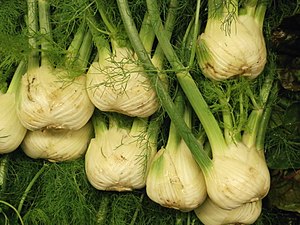Cookbook:Fennel
| Fennel | |
|---|---|
  | |
| Category | Vegetables |
Cookbook | Recipes | Ingredients | Equipment | Techniques | Cookbook Disambiguation Pages | Ingredients | Vegetables | Spices and herbs
Fennel is a plant used as both a vegetable and a spice.
Characteristics
[edit | edit source]All types of fennel have green stalks and feathery dill-like leaves.[1][2] After flowering, they produce small, elongated seeds with a brownish color and ridges around the outside.[3] However, broadly speaking, there are three primary varieties of fennel used in cooking:
- Bitter fennel: tall and thin; seed has slightly bitter taste much like celery seed; generally less widely available worldwide[2][4]
- Sweet fennel: mild anise flavor from anethole content; becomes increasingly bitter with age; seeds, leaves, and stalks are used[2][4]
- Florence fennel/bulb fennel/finoccio: sweet variety with a large, bulbous stem base; very mild anise flavor and sometimes called "sweet anise";[1] used primarily as a vegetable[2][5][6]
Seasonality
[edit | edit source]Peak fennel season is fall through late winter and early spring.[7]
Selection and storage
[edit | edit source]When selecting fresh fennel, either for bulbs, stalks, or leaves, look for vibrant color without browning. The leaves should be fresh with no wilting.[6] Bulbs should be firm, with no cracking.[7][8]
Store fresh fennel in a perforated plastic bag in the fridge. It will last for several days.[7][8] Discard if you see any sliminess. Dried seeds should be stored in an airtight container away from light, heat, and moisture.[1]
Preparation
[edit | edit source]The part of fennel requiring the most preparation is the fresh bulb. You'll want to first cut off any stalks and roots still attached.[7][9] Many people remove the outer part of the bulb, either by removing the entire layer or by using a vegetable peeler to remove a thinner layer.[7][9] You can also either remove or keep the core—it is firmer than the rest, but it is edible. If leaving it in, your slices will hold together.[7][9]
Use
[edit | edit source]All parts of fennel are used in cooking. The seeds are used in Italian, Eastern European, South Asian, and East Asian cuisines,[3][4][7] where they provide a licorice-like flavor. Even the pollen is used as a flavoring.[7] The bulb is used as a vegetable, both raw and cooked—it has a mild vegetal flavor that is well suited to both raw applications like salad and cooked applications such as braising.[2][5][7] The leaves may be used as an herb and garnish,[9] and the stalks can be treated like those of celery.[7]
Substitution
[edit | edit source]Bitter and sweet fennel cannot be readily substituted for each other due to their different flavor profiles. Celery seed is a better substitute for the bitter fennel seed typically used in Central/Eastern European cuisine.[2]
Recipes
[edit | edit source]References
[edit | edit source]- ↑ a b c Friberg, Bo (2016-09-13). The Professional Pastry Chef: Fundamentals of Baking and Pastry. Wiley. ISBN 978-0-470-46629-2.
- ↑ a b c d e f Davidson, Alan (2014-01-01). Jaine, Tom (ed.). The Oxford Companion to Food. Oxford University Press. doi:10.1093/acref/9780199677337.001.0001. ISBN 978-0-19-967733-7.
- ↑ a b Labensky, Sarah R.; Hause, Alan M.; Martel, Priscilla (2018-01-18). On Cooking: A Textbook of Culinary Fundamentals. Pearson. ISBN 978-0-13-444190-0.
- ↑ a b c Farrimond, Dr Stuart (2018-11-06). The Science of Spice: Understand Flavor Connections and Revolutionize Your Cooking. National Geographic Books. ISBN 978-1-4654-7557-2.
- ↑ a b Van Wyk, Ben-Erik (2014-09-26). Culinary Herbs and Spices of the World. University of Chicago Press. ISBN 978-0-226-09183-9.
- ↑ a b Gisslen, Wayne (2014-04-15). Professional Cooking. Wiley. ISBN 978-1-118-63672-5.
- ↑ a b c d e f g h i j Hutcherson, Aaron (2021-03-25). "How to embrace fennel and add its subtle sweetness to your cooking" (in en-US). Washington Post. ISSN 0190-8286. https://www.washingtonpost.com/food/2021/03/26/fennel-guide-tips-recipes/.
- ↑ a b Kipfer, Barbara Ann (2012-04-11). The Culinarian: A Kitchen Desk Reference. Houghton Mifflin Harcourt. ISBN 978-0-544-18603-3.
- ↑ a b c d "How to Cut Fennel". Serious Eats. Retrieved 2024-07-14.
